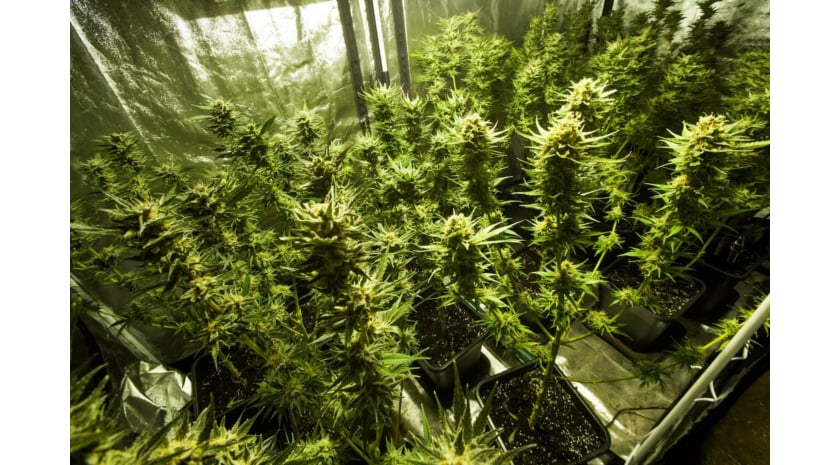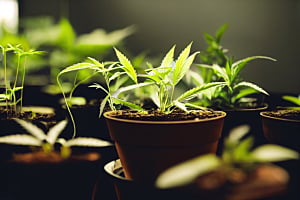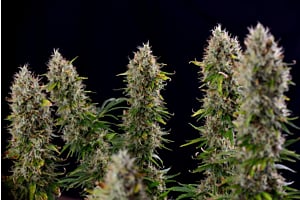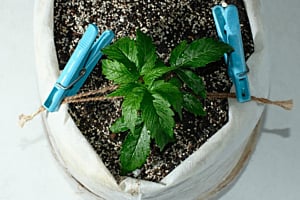Table of Contents
- Growing weed indoors: The basics
- Best place to set up an indoor grow room
- What is the best medium for growing weed indoors?
- How to create the perfect growing environment for cannabis
- Which cannabis feeding system should you use?
- How much power will you use growing weed indoors?
- Does growing weed seeds indoors use much water?
- Control the smell of growing cannabis
- Top tips for caring for your indoor cannabis grow
- Growing weed indoors – Frequently asked questions
- Taking the leap
Seeing how short life is, we must make time to do the things we love. For many cannabis enthusiasts, this often includes growing their weed indoors.
For a first-time grower, getting started can be a confusing endeavor. You'll need to choose an appropriate space and acquire the necessary equipment for growing weed indoors. You've also got to familiarize yourself with setting up a grow room, which weed seeds to invest in, and crop maintenance.
Then there are the legalities. SeedSupreme doesn't promote the unlawful growing of cannabis, so you'll need to ensure that home cultivation is legal in your state before getting started.
Assuming that you're legally allowed to continue: By following and implementing the detailed steps as laid out in our beginner's guide to growing weed indoors, you can rest assured that spending time on your favorite pastime will be well worth the effort.
Growing weed indoors: The basics
Growing weed indoors is a rewarding practice that you can pursue in any climate. However, it requires attention to detail, time, money, and the right equipment.
While growing weed plants indoors needs a hands-on approach, and gardening in itself is therapeutic, it also comes with a host of benefits that makes it more than worth your while, including:
- Crop consistency and reproducibility
- Total environmental control over the grow space
- Privacy and security
- Year-round cultivation
- Control over your crops' flowering period
- Risk mitigation and fewer pests
The key to successfully growing weed indoors lies in artificially creating the ideal environment and optimal conditions for every stage of your crops' lifecycle. To achieve this goal, you need to provide your plants with precise environmental conditions.
If you're a detail-oriented cannabis enthusiast with a knack for gardening, you should find our version of "growing weed indoors 101" very useful.
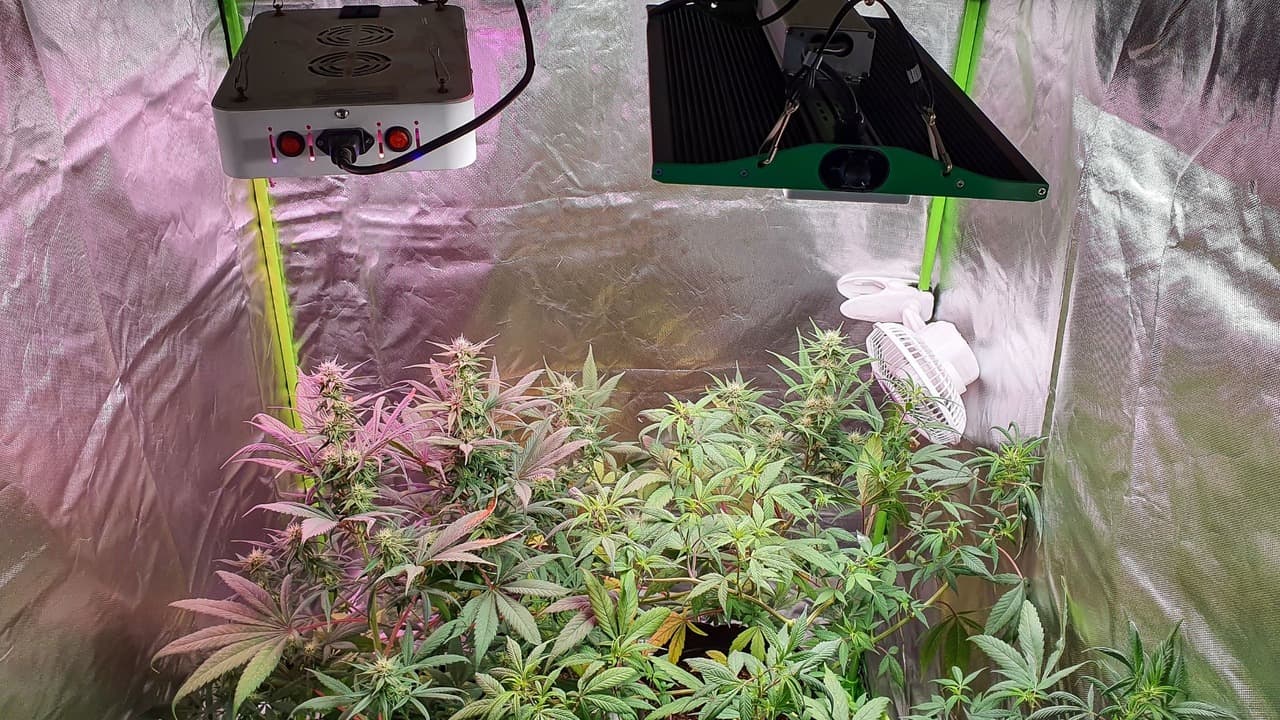
Best place to set up an indoor grow room
Growing weed indoors requires you to choose your cultivation space carefully. First-time cultivators should consider a small, cheap indoor grow setup, as common newbie mistakes will be less costly. As you gain experience, you can gradually increase the size of your grow space.
You need to ensure that the area is dedicated to growing your weed plants indoors, as it isn't wise to move them around. It should also be close to a window so you can easily vent the stale, smelly air from your grow space to the outside.
While weed growing indoors does require a somewhat specialized setup, the best and cheapest option for newbie growers is small grow tents. More experienced cultivators should consider setting up their own grow room. The following areas are ideal for this purpose:
- Basement
- Garage
- Attic
- Unused spare room
- Closet or cabinet
Take note: While designing your indoor grow room, there must be enough space for your weed plants, lights, ducting, fans, other equipment, and a worktable.
Indoor space or grow tent
Before you start growing weed indoors, you need to consider your choices for setting up a grow area.
If you have space, such as a basement or garage and resources at your disposal, building a dedicated area to grow your weed plants indoors is an excellent option. It allows you to tailor-fit your cultivation operation to your needs by constructing a solid, sealed-off room made out of PVC, wood, etc., dedicated to growing marijuana.
Growing weed indoors using a grow tent, on the other hand, eliminates the construction expense and issues such as where to hang your lights. These units are purpose-built, offering convenience, portability, fast setup, built-in hangers and ports, highly reflective interiors, and light-proof enclosures.
Sizes vary from 2x4x5 feet (ideal for 250-watt grow lights) to 4x8x9 feet (capable of handling 1,000-watt cultivation lamps), with the largest units typically priced around $950, significantly cutting the cost of growing weed indoors.
Indoor climate
When growing weed indoors, it's crucial to the health of your crop to maintain the ideal humidity and temperature when the lights are both on and off. While some marijuana strains prefer cool and dry climates, others like it hot and humid.
To create a suitable climate for growing weed indoors, you need to install humidification, and air conditioning (AC) systems in your grow space. These units' strength is typically dictated by the size of the room and the amount of heat produced by your lights and other equipment.
To circulate the air surrounding weed growing indoors in:
- An open room: The use of exhaust and intake fans will be sufficient to ventilate the air and maintain constant temperatures
- Sealed rooms: A mini-split AC system will regulate the humidity and cool the grow space without bringing in fresh air
The ideal climate conditions for growing your weed plants indoors are:
- Vegetative stage: 71–82 ℉ with lights-on and 64–74 ℉ after lights out. The relative humidity should be 40–70%
- Early flowering phase: 68–79 ℉ with the moisture level not exceeding 50%
- Flowering phase (lasts two weeks): 64–75 ℉ with a humidity level between 30–40%
Lights
When you're growing weed from seed indoors, the grow lamps play a considerable role in determining your crop yield's quantity and quality. If you're passionate about marijuana cultivation and plan on doing it long-term, it's worth investing in a good lighting setup.
Here's a brief breakdown of the best lights for growing weed indoors:
- Light-emitting diode (LED) panels
LED grow panels are significantly more expensive than other options. They're designed for growing weed indoors and are highly efficient for use during both the veg and flowering stages. These fixtures are energy efficient and produce little heat.
- HID grow lights
High-intensity discharge (HID) lights are the most frequently used option for growing weed indoors. They provide the best value for money in terms of ease of operation, efficiency, and cost. However, they produce a considerable amount of heat, so you must ensure that your grow room is well ventilated with a decent AC system.
Cultivators typically use two HID setups:
Metal halide (MH) lights are the preferred option during the vegetative stage
For the flowering stage, growers typically switch to high-pressure sodium (HPS) lamps
- Fluorescent grow lights
Fluorescent lights are the cheapest and easiest to use option for growing weed indoors. They may be less powerful than other setups, but they're great for propagating young plants and those with a low yield expectancy. They give off very little heat, making them an excellent option for first-time growers cultivating one or two plants in a small grow area.
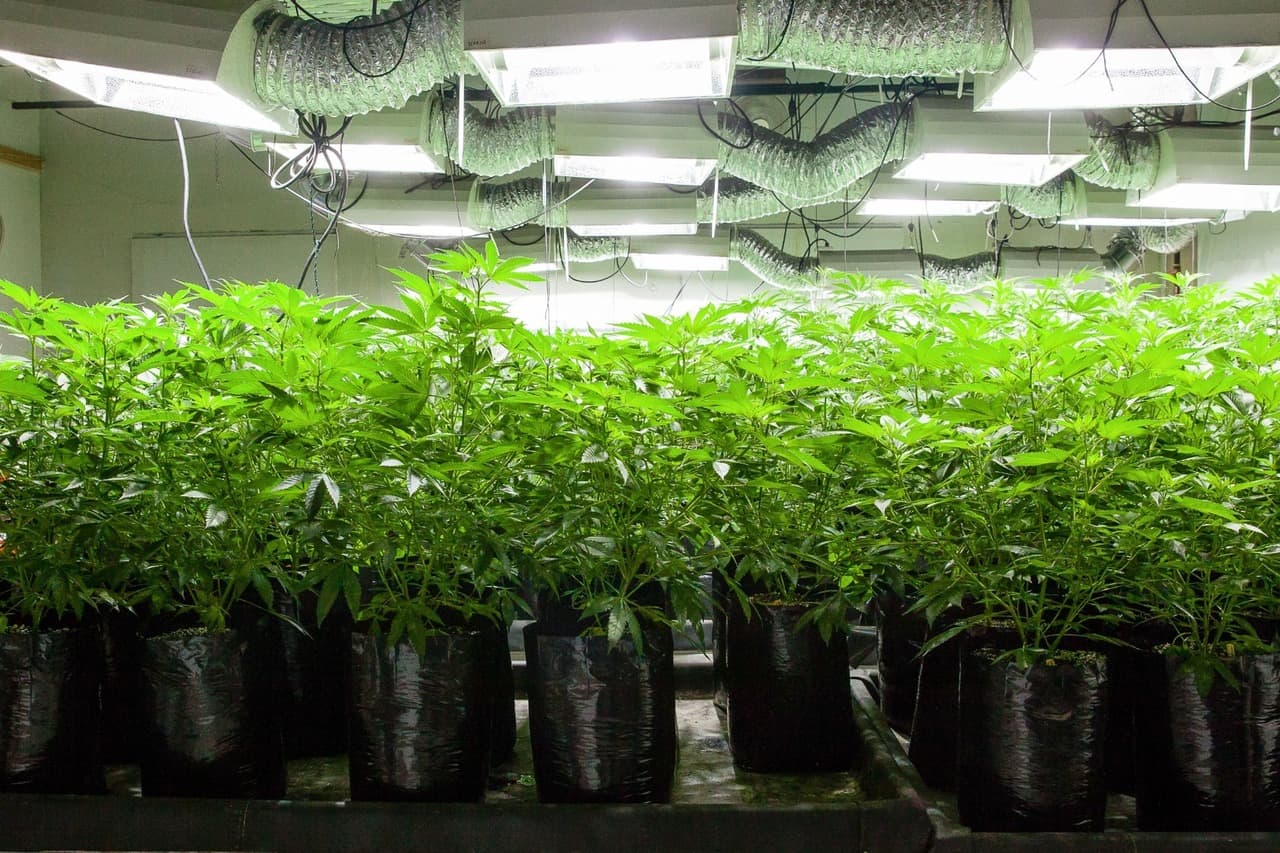
Timers and automation
When growing weed from seed indoors, your cannabis plants' light exposure is crucial to their development. It determines the changeover between the vegetative and flowering stages, making it essential to provide your crop with a consistent daily light schedule.
Investing in a timer will automate this process. After installation, it's essential to check the device once a week to ensure it's functioning properly.
More experienced growers may want to consider automating their AC unit by installing a thermostat to maintain optimal temperatures within the grow room, keeping it ideal for weed growing indoors.
Installing digital environmental controllers are also well worth the expense. These gadgets grant you full, automated control over your indoor grow space. You can connect these units to AC's, heaters, humidifiers, dehumidifiers, and fans and set thresholds, automatically turning these devices on or off based on your settings.
After setting up your indoor grow space, you need to consider which growing medium best suits your operation.
What is the best medium for growing weed indoors?
Soil is the most traditional and forgiving medium you can use, making it an ideal choice for novice cultivators. More experienced growers may want to consider growing hydroponic weed using Hydroton, coco coir, or other soilless mediums.
Let's take a quick gander at the most common mediums used for growing weed indoors.
Hydroponics
Growing weed hydroponically indoors results in more vigorous growth and potentially higher yields. While this technique requires fewer nutrients (nutes) and less water, monitoring systems are necessary to maintain a stable pH level.
Although it's a viable alternative to soil, it's a more advanced technique that doesn't come without its challenges, making it more suitable for experienced cultivators.
In essence, hydroponics (hydro) involves the growing of weed indoors in a nutes solution, with an inert medium for root support or without it. Using media such as clay pellets (Hydroton,) coco coir (coco,) Rockwool (chalk,) or fused basalt rock can significantly improve nutrient delivery.
Soil
Growing weed indoors in soil is the best option for first-time cultivators, as it requires less precision when you're feeding and watering your crop. A stable pH foundation and less frequent watering will help secure a successful first harvest when using this media.
Soil for growing weed indoors typically contains all the nutes and beneficial microbes necessary to keep your plants healthy. Unfortunately, it can also create a favorable environment for mildew, mold, and pests to spread. It's also messy to work with.
The best soil for growing your weed indoors is any high-quality potting dirt. Earth containing artificial extended release fertilizers, such as Miracle-Gro, is unsuitable for cannabis cultivation.
Soilless mediums
Cultivators growing weed hydroponically indoors typically use soilless media such as Rockwool, coco, and Hydroton to provide root support for their plants and boost nutrient delivery. Many advanced growers mix these mediums in custom quantities, creating unique blends tailored to their specific growing environment and style.
Here's a brief breakdown of some of the most frequently used soilless mediums:
Rockwool
When growing weed hydroponically indoors, Rockwool is most commonly used during the initial stages of a cannabis plant's life. It's an inert substance composed of rock or mineral fibers) and it provides a reasonably sterile environment. It has unique water retention properties and will quickly expose any feeding or watering mistakes.
Coco Coir
Coco is composed of the fibrous material found in and on coconut shells. Cultivators favor it for being a renewable and sustainable medium, making it cost-effective for use when growing weed hydroponically indoors.
This inert medium has a neutral pH, and it doesn't maintain or provide nutes. More experienced cultivators that prefer growing their weed indoors benefit from this media as it allows them to make pH and nutrient changes quickly. It can be used by itself, added to soil, or combined with another medium such as Hydroton to improve growth capability and drainage.
Hydroton
This lightweight expanded clay aggregate contains porous clay pebbles. It can be used when growing weed hydroponically indoors, blended with other soilless mediums, or soil. While Hydroton isn't great for water retention, it's excellent for ensuring that your plants' roots receive equal levels of oxygen. It's essential to keep it hydrated, though.
How to create the perfect growing environment for cannabis
In contrast to cultivating cannabis in a greenhouse or outside, when growing weed indoors, you have full control over the elements, granting you the ability to raise your crop under optimal conditions.
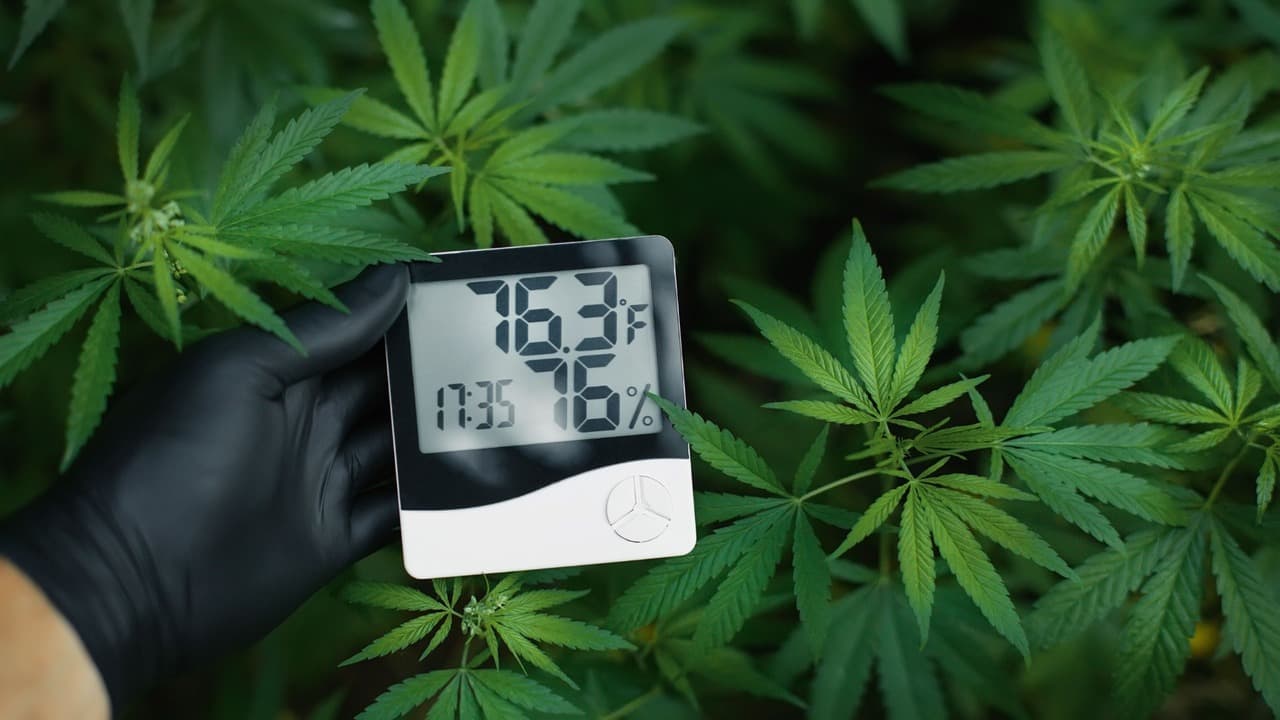
Temperature and humidity
To control the relative humidity and heat when you're growing your weed plants indoors, you need to install AC and humidification systems. These unit's capacities depend on how big your cultivation area is and the heat produced by the installed equipment.
Air circulation
Air circulation helps to prevent microbes and pests from gaining access to your crop while creating a stable environment in your grow room. When growing weed indoors, the easiest way to provide proper ventilation is by strategically placing oscillating fans throughout the grow space. Remember, the idea is to mimic a light breeze.
Carbon Dioxide
If you’re growing your weed plants indoors, it’s essential to control the level of carbon dioxide (CO2). Cannabis plants convert CO2 into sugar through photosynthesis which they then use as energy to develop throughout their lifecycle and ultimately grow seeds or flowers. Increasing the levels of this element around your indoor garden can significantly improve your crop’s yield.
Best nutrients for growing weed indoors
Weed growing indoors requires a considerable amount of nutrients and fertilizer throughout their lifecycle.
While soil naturally provides these supplements, hydroponic systems are void of nutes. Using a hydro setup, it's your responsibility to provide the minerals necessary to feed your plants. Keep in mind, as your marijuana plants develop, their nutrient needs change.
Therefore, the best nutrients for growing weed indoors depend on the type of cannabis plants you're raising and their development stage. For instance, crops during the vegetative stage require more nitrogen, while they’ll need higher amounts of potassium and phosphorus during the flowering period.
Which cannabis feeding system should you use?
Feeding weed growing indoors comes down to providing your crop with the compounds and chemicals it needs to develop and ultimately produce heavy, resinous buds. The two main feeding system types are:
- Drain-to-waste: Applies fresh nutes to the growing medium during every feeding session. Nutrients that drain through are wasted and not reused.
- Recirculating system: Collects used water and nutrients, replenishes them with fewer fresh nutes and reapplies the solution to your crop the next time you feed it. It's crucial to check pH levels before adjusting the mixture and again after if you're using this technique.
When growing your weed indoors in soil, drain-to-waste is your only option.
If you're growing your weed hydroponically indoors, the system you choose depends on your preference. Drain-to-waste grants you full control over the nutrient application, while recirculating systems are more cost-effective but require more cultivation experience to use.
The most frequently used cannabis feeding techniques are:
- Top feed drain-to-waste system
- Ebb and flow method
- Nutrient film technique (NFT)
- Deep Water Culture (DWC) system
How much power will you use growing weed indoors?
Factors that determine your power usage when growing weed from seed indoors include:
- The size of your setup
- Type of growing space (Cupboard, grow tent or room, etc.)
- Strength and type of lighting
- The capacity of your AC, humidifying systems, and other electrical equipment
- Number and variety of cannabis plants your cultivating
To determine the amount of power your operation will use, you need:
- Calculate the total amount of watt-hours for all your equipment. For instance: Lamp veg stage = (18 hours x 28 days) x 500W = 252 000 watt-hours
- Determine the number of kilowatt-hours by combining the watt-hours of your equipment and dividing the total by 1,000
- Multiply the total number of kilowatt-hours with the average cost of power per unit. For instance: 703,48 KW x 0.24 (price per KW) = $168.84 (total cost of power)
Does growing weed seeds indoors use much water?
When you water weed growing indoors, there's a fine balance between giving them enough and too much. Overwatering cannabis plants will affect their productivity, potentially stunting or killing them.
There are a few factors that determine the watering frequency and how much water marijuana plants needs, including:
- The crop's size
- The development stage
- The plant's growth rate
If you're growing weed indoors in soil, it's essential only to moisten the soil when watering your plants rather than drenching them, and only when they're almost dry. Also, make sure the growing containers have drainage holes.
Control the smell of growing cannabis
Regardless of your operation's size, cannabis odors can quickly overtake an entire house if left unattended. When weed growing indoors transitions into the flowering period, your plants start developing trichomes and produce terpenes, boosting the smell they give off. To mitigate the unpleasant fragrance your crop releases, you need to:
- Check humidity and temperature levels: Too much moisture and heat sustains and boosts odors
- Provide your crop with proper air circulation: It'll help bring down moisture and heat levels and mitigate the smell
- Use odor absorbing gels to mask weed odors with other scents
- Install activated carbon filters: Removes contaminants from the air by employing highly ionized carbon to attract odor-carrying particulates and trapping them in a filter
Top tips for caring for your indoor cannabis grow
Tip 1 – Careful planning
When growing weed from seed indoors, the health of your crop entirely depends on the equipment you select and the quality of the environment you create. While it's easy to acquire a new line of nutes, it's quite another story to replace an inefficient or undersized AC.
Meticulous planning while designing your indoor grow space will save you many headaches and potentially a sizable chunk of money down the road.
Tip 2 – Keep it clean
If you're growing weed plants indoors, cleanliness in your cultivation chamber is crucial. It's essential to clean the entire growing area with a 3–5% hydrogen peroxide solution before planting your first crop and after every harvest. Be sure to scrub down the fans, lights, reservoirs, irrigation lines, trays, floors, and walls using this solution.
Tip 3 - Keep a grow journal
One of the easiest and cheapest things you can do to improve your skills as a cannabis cultivator is to keep a journal for your weed growing indoors. Logging all major aspects, such as water and feeding amounts, temperature, and humidity levels can help pinpoint problems.
Tip 4 – Monitor the pH
While growing weed indoors, it's crucial to monitor the pH of your growing medium and the water you're using. Incorrect pH levels can prevent your plants' roots from absorbing specific nutrients, causing cannabis deficiencies, ultimately resulting in a reduced yield.
To check your water’s pH level, fill a sterile container and let it sit for a while, then use a pH meter to measure the alkalinity of the H2O in the holder.
The ideal pH levels for hydro setup using inert substrates are:
- 5.8–5.9 pH during the first few weeks of growth
- 6.0–6.2 pH while your plants are in the pre-flowering stage
- 6.0–6.3 pH after your shrubs entered the flowering period
Tip 5 - Maintain proper ventilation
If you're growing weed seeds indoors, it's critical to maintain proper airflow within the grow room. Adequate ventilation can prevent mold from taking hold in the buds, avert nutrient burn, and help cool down the cultivation environment.
Growing weed indoors – Frequently asked questions
What is the most common mistake typically made by indoor growers?
When growing weed indoors, growers most commonly mess up the lighting schedule. Your crop's light exposure is dependent on its stage of development. During the vegetative phase, your plants should get about 18 hours of illumination per day, which you must reduce to twelve hours during the flowering period.
Which can I do to increase the yields of my cannabis crop?
There are many ways to increase your yield with weed growing indoors. You can start by choosing your seeds wisely and picking a growing medium with sufficient nutrients and correct moisture content. After you've planted your marijuana, minimize fertilizer usage when your crop reaches its growth stage.
When should I harvest my cannabis crop?
If you're growing weed plants indoors, your crop's success largely depends on when you harvest and how you cure your cannabis. Harvesting too soon will result in a reduced yield. The best time to reap your reward is when half of the hairs on the buds have gone dark in appearance.
To cure your buds, hang them upside down in a dry, dark, and well-ventilated room.
Taking the leap
With the sheer amount of information available regarding growing weed indoors, it's no wonder that first-time growers often get confused.
Our beginner's guide to growing weed indoors is aimed at alleviating most of this confusion. Although cultivating marijuana is an amazing experience, it's also a learning curve. As a cultivator, you're bound to make mistakes. However, following the pointers outlined above will get you back on track in no time whatsoever, making it all worth your while in the end.
Investing in premium indoor weed seeds will significantly improve your chances of successfully raising your cannabis crop.
At SeedSupreme, we keep in mind that not all cultivators have the same amount of experience. For that reason, we offer a huge selection of the finest quality indoor autoflowering seeds, making life easier for first-time growers. Log on to our online store and order your first batch of seeds today!

 THC
THC